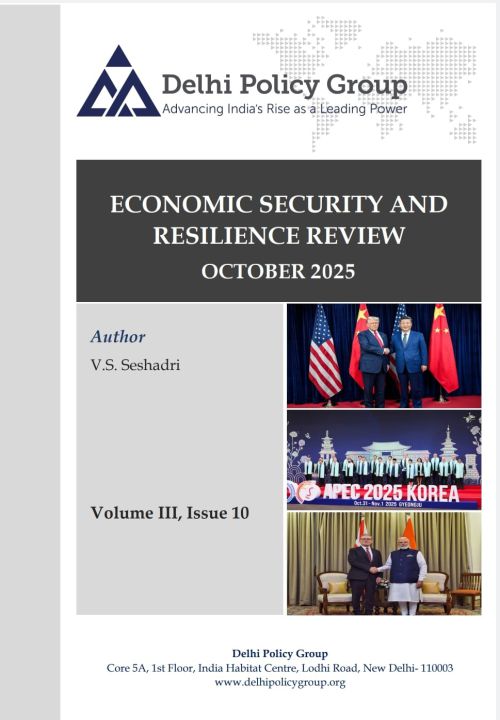Economic Security and Resilience Review
The summit meeting between President Donald Trump and President Xi Jinping held on October 30 at Busan in the Republic of Korea has resulted in a temporary truce for one year in the ongoing US-China trade war, as the leaders mainly agreed to withdraw some recent restrictive and retaliatory measures announced by the two sides. It also brought down the tariffs applicable on China’s imports into the US (by 10%) to 47%, with China in turn agreeing to resume purchases of US soya, corn and other agricultural products. This does not, however, fundamentally address underlying structural issues or differences.
Some relief for the world at large will come from the otherwise imminent impact of Beijing’s sweeping export control measures on rare earths, that were applicable worldwide and were to go into effect from December 1, 2025. This issue analyses in some detail these developments, and what may lie ahead. Noteworthy also from an Indian standpoint was the total absence of reference to China’s continued purchase of Russian energy products, indicative of persistent double standards.
This issue also brings out other trade and investment related agreements signed during President Trump’s visit to Malaysia, Japan and South Korea, as also the critical minerals agreements signed by him with the leaders of Australia, Malaysia, Thailand and Japan. It points out how these bilateral agreements on critical minerals differ from the Biden administration’s initiative towards concluding a regional Indo Pacific Economic Forum (IPEF), which is now in limbo.
The APEC summit held in Gyeongju in Republic of Korea from October 31 to November 1 was another illustration of the growing polarisation on trade, investment and economic security approaches facing the region. While President Trump himself skipped the event, the speeches made at the summit brought out the contrasting approaches. However, the declaration released at the end of the summit glossed over them and refrained from any prescriptive approaches beyond calling for strengthened cooperation and actions that benefit all.
The Fourth Plenum of the Communist Party of China issued a communique on October 23, 2025 upon its conclusion. The Plenum inter alia adopted recommendations for formulating the country’s 15th five year plan. In the context of the ongoing tariff and technology war between China and the US, what has attracted wide attention is its call for steering the development of new quality productive forces and further enhancing the overall performance of China’s innovation system.
Meanwhile, the month also saw the US and the UK announcing sanctions on Russia’s two largest oil companies Rosneft and Lukoil. The European Union, too, announced its nineteenth package of sanctions against Russia that expands sanctions on Russian tankers. These measures are expected to adversely impact Indian procurement of Russian oil products.
The EU has reset its steel import measures, halving the tariff free quota and increasing the out of quota duty from the present 25% to 50%. There is a concern among Indian steel makers that coupled with the CBAMs which will become effective in January 2026, this would be a double whammy for Indian exporters.
China has formally lodged a complaint at the WTO against India’s production linked Incentives (PLI) schemes for electric vehicles, advanced chemistry cells and auto components. This is ironic, considering the huge amounts of subsidies that China has poured into developing these sectors indigenously which is what has helped it to acquire market dominance.
To read this issue of the ESRR, Vol. III, Issue 10, please see the PDF attached



